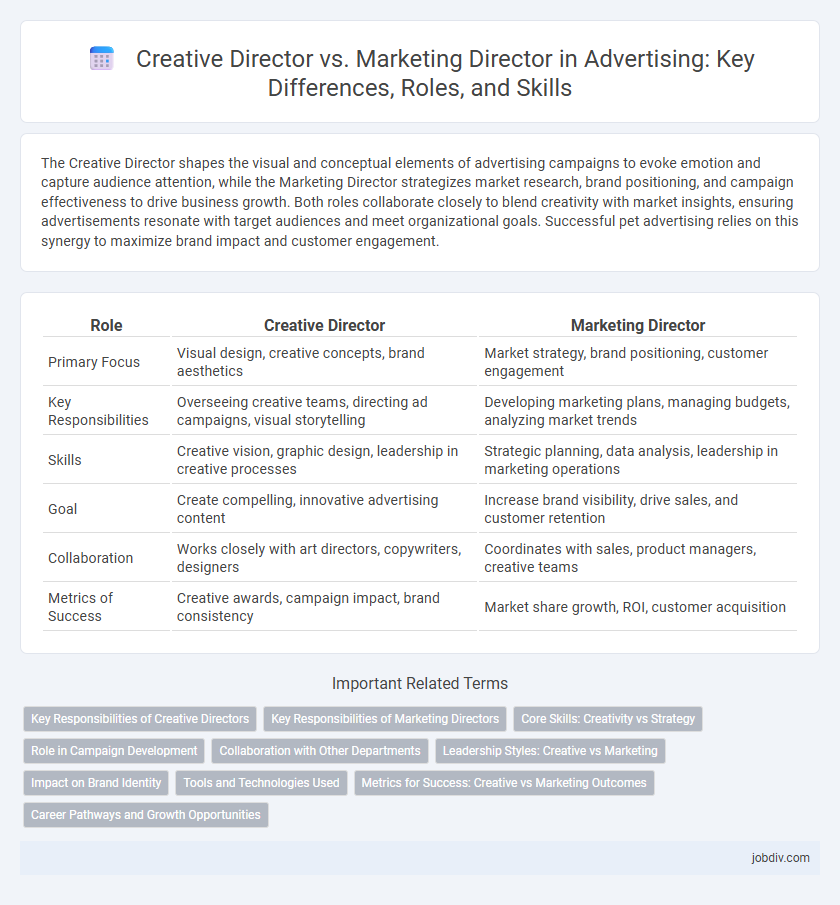The Creative Director shapes the visual and conceptual elements of advertising campaigns to evoke emotion and capture audience attention, while the Marketing Director strategizes market research, brand positioning, and campaign effectiveness to drive business growth. Both roles collaborate closely to blend creativity with market insights, ensuring advertisements resonate with target audiences and meet organizational goals. Successful pet advertising relies on this synergy to maximize brand impact and customer engagement.
Table of Comparison
| Role | Creative Director | Marketing Director |
|---|---|---|
| Primary Focus | Visual design, creative concepts, brand aesthetics | Market strategy, brand positioning, customer engagement |
| Key Responsibilities | Overseeing creative teams, directing ad campaigns, visual storytelling | Developing marketing plans, managing budgets, analyzing market trends |
| Skills | Creative vision, graphic design, leadership in creative processes | Strategic planning, data analysis, leadership in marketing operations |
| Goal | Create compelling, innovative advertising content | Increase brand visibility, drive sales, and customer retention |
| Collaboration | Works closely with art directors, copywriters, designers | Coordinates with sales, product managers, creative teams |
| Metrics of Success | Creative awards, campaign impact, brand consistency | Market share growth, ROI, customer acquisition |
Key Responsibilities of Creative Directors
Creative Directors lead the development of innovative visual concepts and guide creative teams to execute compelling advertising campaigns that align with brand identity. They oversee the artistic aspects of marketing materials, including design, copywriting, and multimedia production, ensuring consistency across all channels. Their role emphasizes creativity, storytelling, and brand aesthetics to effectively engage target audiences and differentiate the brand in competitive markets.
Key Responsibilities of Marketing Directors
Marketing Directors oversee market research, develop strategic campaigns, and analyze consumer behavior to drive brand growth and increase ROI. They coordinate cross-functional teams to execute advertising strategies aligned with business goals and monitor campaign performance metrics. Their role prioritizes aligning marketing initiatives with sales objectives to enhance market positioning and customer engagement.
Core Skills: Creativity vs Strategy
Creative Directors excel in visual storytelling, concept development, and innovative design, driving the artistic vision of campaigns. Marketing Directors specialize in market research, strategic planning, and data analysis to optimize campaign effectiveness and customer engagement. The core distinction lies in Creative Directors focusing on creativity and execution, while Marketing Directors emphasize strategic direction and business impact.
Role in Campaign Development
Creative Directors shape the visual and conceptual elements of advertising campaigns, focusing on storytelling, design, and brand identity to engage the target audience effectively. Marketing Directors develop overall campaign strategies, including market research, budgeting, and performance analysis to ensure alignment with business goals and ROI. Collaboration between these roles drives cohesive campaigns that blend creativity with strategic market positioning.
Collaboration with Other Departments
Creative Directors and Marketing Directors collaborate closely with departments such as Sales, Product Development, and Analytics to align campaign strategies with brand objectives. The Creative Director leads the visual and conceptual design teams to ensure cohesive messaging, while the Marketing Director integrates market research and customer insights for targeted outreach. Effective interdepartmental communication drives innovation and maximizes campaign impact across multiple channels.
Leadership Styles: Creative vs Marketing
Creative Directors lead with an imaginative and visionary approach, inspiring teams to push artistic boundaries and develop compelling content. Marketing Directors emphasize data-driven strategies and market analysis to optimize campaigns and achieve measurable business goals. Their leadership styles reflect a balance between fostering innovative creativity and ensuring strategic market alignment.
Impact on Brand Identity
A Creative Director shapes the visual and conceptual elements of brand identity, ensuring cohesive storytelling through design, video, and advertising campaigns that resonate emotionally with the audience. A Marketing Director strategizes brand positioning and market outreach, leveraging data-driven insights to amplify brand awareness and drive growth across multiple channels. Both roles critically influence brand perception, with the Creative Director focusing on aesthetic and narrative cohesion, while the Marketing Director prioritizes market engagement and brand equity development.
Tools and Technologies Used
Creative Directors primarily utilize design software like Adobe Creative Suite, prototyping tools such as Sketch and Figma, and project management platforms including Asana and Trello to develop compelling visual campaigns. Marketing Directors rely on analytics tools like Google Analytics, CRM systems such as Salesforce, and digital advertising platforms including Google Ads and Facebook Business Manager to strategize and optimize marketing efforts. Both roles integrate collaboration tools like Slack and data visualization software to enhance communication and decision-making processes.
Metrics for Success: Creative vs Marketing Outcomes
Creative Directors prioritize metrics such as audience engagement, brand recognition, and campaign originality, measuring success through emotional impact and visual storytelling. Marketing Directors focus on quantifiable outcomes like conversion rates, return on investment (ROI), and customer acquisition cost, emphasizing data-driven results and market reach. Both roles use distinct key performance indicators (KPIs) tailored to creative influence versus business growth in advertising campaigns.
Career Pathways and Growth Opportunities
Creative Directors typically begin their careers in graphic design, copywriting, or art direction, progressing through roles that emphasize creative development and project management. Marketing Directors often start in market research, brand management, or digital marketing, advancing by gaining expertise in strategic planning, campaign execution, and data analytics. Growth opportunities for Creative Directors include roles such as Chief Creative Officer, while Marketing Directors often move towards Chief Marketing Officer positions, both requiring leadership skills and cross-functional collaboration.
Creative Director vs Marketing Director Infographic

 jobdiv.com
jobdiv.com